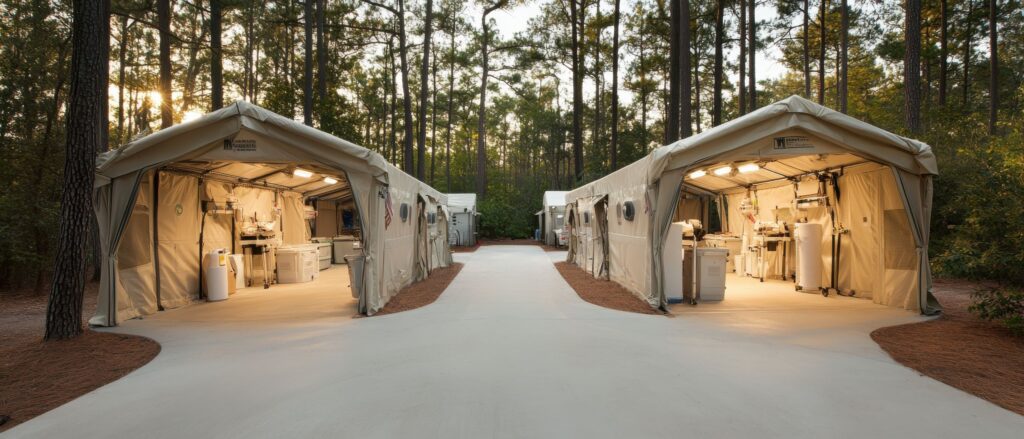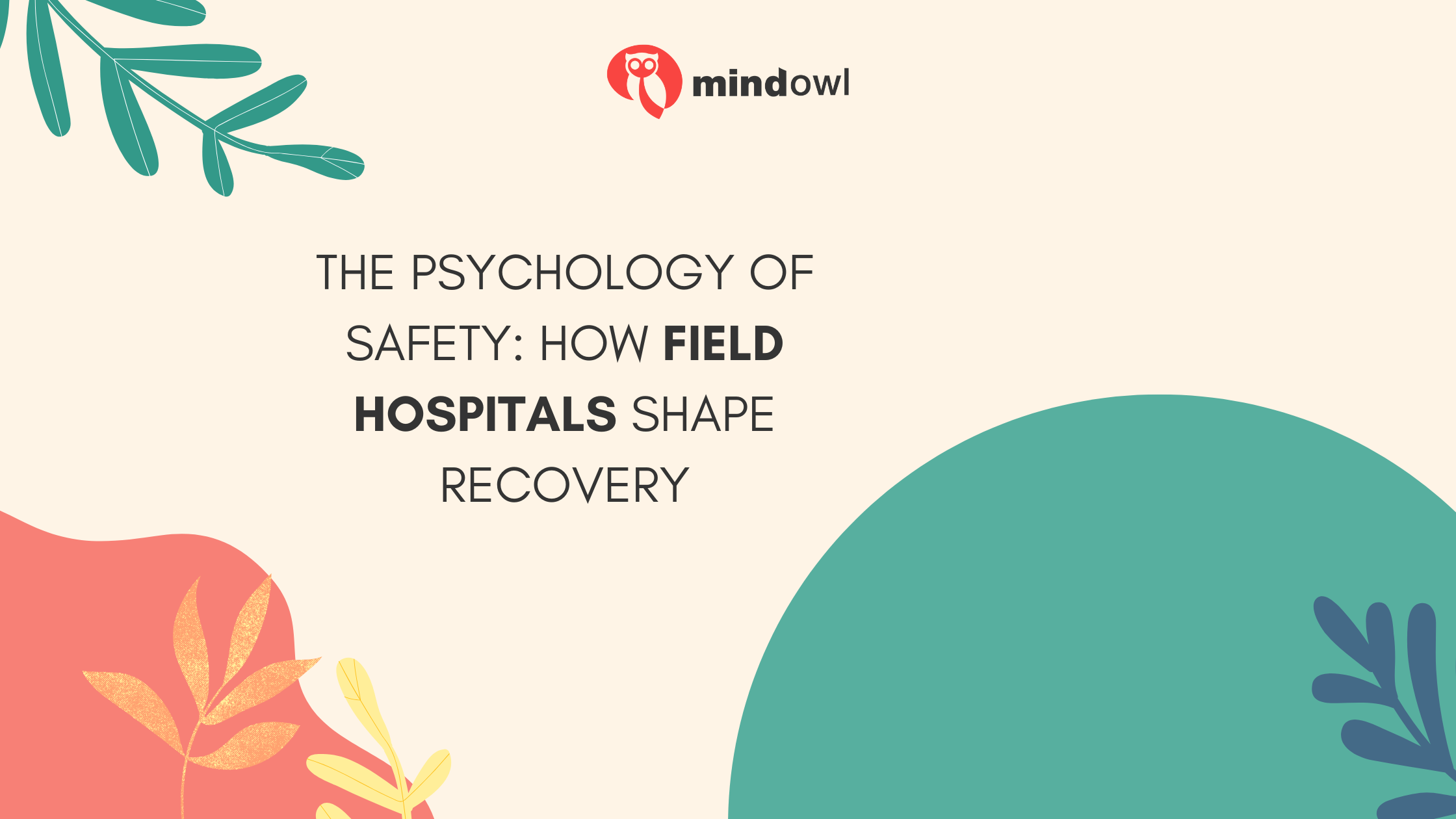
Field hospitals are temporary medical facilities that play a critical role in disaster zones, conflict areas, and public health emergencies. Beyond their primary function of treating physical injuries, they also have a deep psychological impact on patients and communities. In this article, you’ll learn how field hospitals foster a sense of safety, stability, and hope, which are key factors in emotional and physical recovery.Key Takeaways
- Field hospitals provide critical medical care in disasters, conflicts, and health emergencies while also fostering psychological recovery through safety and stability.
- These mobile units offer scalable treatment spaces, infection control, and rapid deployment, functioning as full-service medical centers in crisis zones.
- Beyond physical treatment, field hospitals reduce anxiety, offer social support, integrate mental health care, and serve as symbols of hope.
- Emerging technologies like AI triage, drone logistics, and predictive analytics are enhancing field hospital efficiency and response capabilities.
What Are Field Hospitals?
Field hospitals are mobile or semi-permanent medical units set up in emergencies where traditional healthcare infrastructure is unavailable or overwhelmed. They are commonly deployed during natural disasters (such as earthquakes or hurricanes), war zones, refugee crises, and large-scale public health outbreaks like pandemics.
Staffed by military medical teams, NGOs, or disaster response organizations, these facilities offer emergency care, surgeries, and sometimes long-term treatment until permanent hospitals can resume normal operations.
Field Hospital Capabilities
A deployable field hospital represents a critical advancement in emergency medical response, which delivers full-spectrum care when traditional facilities are compromised. These modular systems can transform any suitable site into a functional medical center within 72 hours, featuring:
• Scalable treatment spaces from basic triage to surgical suites
• Military-grade environmental controls for any climate
• Optimized layouts ensuring infection control and workflow efficiency
• Flexible configurations for disasters, conflicts or disease outbreaks
The deployable field hospital’s unique value lies in its rapid-response capability combined with hospital-grade care standards. These mobile units maintain all critical functions, from emergency medicine and surgery to isolation wards and diagnostic services, while being designed for multiple redeployments across different crisis scenarios. Their presence not only addresses urgent medical needs but also provides psychological reassurance to affected communities through visible, professional care infrastructure.
8 Ways Field Hospitals Shape Recovery
When disasters strike, whether a magnitude earthquake, measles outbreak, or influenza (flu) epidemic, mobile field hospitals and emergency field hospitals become lifelines for thousands of people. These facilities, equipped with triage and isolation facilities, operating rooms, and respiratory care units, provide critical medical support while also fostering psychological recovery. Here’s how:
1. Immediate Access to Care Reduces Anxiety
Immediate access to care during disasters significantly reduces anxiety by addressing medical needs swiftly. Emergency field hospitals provide rapid triage, directing patients to trauma clinics or ICUs for stabilization. Prompt treatment prevents conditions from worsening, alleviating physical and emotional distress.
The presence of skilled medical personnel reassures survivors, fostering a sense of security. Without timely intervention, fear and uncertainty can escalate, exacerbating trauma-related anxiety.
Quick medical response not only saves lives but also mitigates psychological suffering, reinforcing resilience in crisis situations. Ensuring rapid care delivery is crucial in disaster management, as it curbs panic, restores hope, and promotes recovery.
2. Structured Environment Promotes Security
A structured environment in disaster response fosters security by replacing chaos with order. Field hospitals, combat support hospitals, and evacuation hospitals implement scheduled care, meal times, and medical rounds, creating predictability amid crisis.
This routine helps survivors regain a sense of stability, reducing feelings of helplessness. Knowing when to expect treatment, food, and rest eases psychological distress, allowing patients to focus on recovery.
In contrast to the disarray of disaster zones, organized medical facilities provide a reassuring framework, reinforcing emotional resilience. By restoring control through systematic operations, structured care environments play a vital role in mitigating trauma and promoting mental well-being.
3. Community and Social Support
Field hospitals serve as vital community hubs where survivors connect with medical staff and fellow patients. In mobile surgical units and triage facilities, shared hardships create bonds, easing feelings of isolation. These interactions foster emotional support, encouraging resilience through collective strength.
By providing a space for mutual understanding and camaraderie, field hospitals help survivors process trauma, reinforcing mental well-being. Social support within these settings accelerates recovery, proving that solidarity is as crucial as medical care in disaster response.
4. Psychological First Aid (PFA) Integration
Modern mobile field hospitals prioritize holistic healing by embedding Psychological First Aid (PFA) within emergency medical care. Crisis counselors work alongside doctors in ERs and recovery tents, offering immediate emotional support to survivors. This early intervention helps individuals process shock, grief, and fear before reactions become entrenched.
PFA reduces the risk of long-term PTSD. Integrating mental health services with physical treatment ensures comprehensive care, acknowledging that trauma wounds are as critical as bodily injuries in disaster recovery. This dual approach fosters faster, more resilient healing.
5. Symbol of Hope and Resilience
The visible presence of a fully operational field hospital equipped with expeditionary capabilities serves as a powerful beacon of hope in devastated communities. As medical personnel triage patients, perform surgeries, and deliver care, their actions embody resilience, showing survivors that recovery is possible.
For those grappling with loss, this organized aid restores faith in the future. The hospital’s temporary yet functional structure symbolizes humanity’s capacity to rebuild, turning despair into determination. In crisis zones, such symbols are as vital as medical treatment, providing the psychological strength needed for long-term healing.
6. Reduced Stigma Around Mental Health
Disasters create shared vulnerability, making mental health struggles a universal experience rather than a personal failing. Field hospitals that integrate psychological services alongside infection control protocols send a powerful message: emotional wounds require treatment just like physical ones.
When survivors see counselors working alongside surgeons in full PPE, mental healthcare becomes normalized as part of comprehensive medicine. This visible integration in crisis settings helps break down barriers, encouraging more survivors to seek support without shame.
7. Adaptive Design for Comfort
Thoughtful design transforms field hospitals into healing spaces that ease distress. Modern facilities incorporate soft lighting, soothing color palettes, and privacy curtains even in high-acuity areas like respiratory units and trauma bays. These intentional touches counteract the sterility of medical environments, reducing patient anxiety during vulnerable moments.
By replacing cold, institutional aesthetics with warm, human-centered spaces, adaptive design helps maintain dignity amid crisis. Such psychologically-informed layouts prove recovery is about creating environments where fear gives way to comfort, and where every design choice quietly supports the emotional journey back to health.
8. Continuity of Care Builds Trust
Recovery hinges on sustained support. Field hospitals coordinating follow-ups, whether for measles outbreaks or earthquake injuries, prevent feelings of abandonment post-discharge.
From mobile medical kits to full-scale combat support hospitals, these facilities do more than treat wounds. They restore dignity, hope, and stability. By blending emergency medical support with psychological care, they shape holistic recovery in the darkest times.
Where to Find Field Hospitals
Field hospitals are strategically deployed by specialized organizations in crisis zones worldwide. Military medical units like the Red Cross and Médecins Sans Frontières often establish frontline trauma centers in conflict areas.
Disaster response agencies, including FEMA, WHO, and national emergency management teams, rapidly erect these facilities after natural catastrophes. Humanitarian NGOs such as International Medical Corps operate field hospitals in refugee camps and underserved regions.
During pandemics or mass casualty events, governments frequently convert convention centers, schools, or mobile units into temporary medical facilities to relieve overwhelmed hospitals. These adaptable treatment centers appear wherever infrastructure fails or populations become suddenly vulnerable to health emergencies.

The Future of Field Hospitals: AI, Drones, and Predictive Deployment
Field hospitals are transforming through technological innovations that enhance emergency medical response. Artificial intelligence, autonomous drones, and predictive analytics are creating more efficient systems for delivering care in crisis situations.
1. AI-Powered Triage and Diagnostics
Artificial intelligence is revolutionizing field hospital operations by enabling real-time patient assessment. AI systems analyze vital signs, injury severity, and medical history to prioritize treatment rapidly.
During the COVID-19 pandemic, these algorithms demonstrated their value by predicting intensive care needs and optimizing resource allocation. Future applications may include portable diagnostic tools that assist medics in remote locations without specialist support.
2. Drone Supply Chains
Autonomous drones are overcoming logistical challenges in disaster zones by delivering critical medical supplies. Successful implementations, like Zipline’s African operations, have transported blood products and vaccines across difficult terrain.
This technology ensures timely delivery of life-saving materials to field hospitals, even when traditional infrastructure fails. Ongoing programs are developing drone hubs to create resilient supply networks for mobile medical units.
3. Predictive Analytics
Advanced modeling systems now forecast medical emergencies by analyzing meteorological, epidemiological, and geopolitical data. These tools enabled preemptive responses to COVID-19 surges and could integrate real-time data from wearable devices in disaster areas. Satellite imagery and social media monitoring may provide early warnings of refugee movements or disease outbreaks, allowing proactive deployment of medical resources.
4. Emerging Technologies
Future field hospitals may incorporate 3D printing for on-site medical device manufacturing and robotic surgical systems for advanced procedures in remote locations. These innovations will evolve field hospitals from temporary solutions into intelligent, adaptive networks capable of delivering high-quality care anywhere.
Bottom Line
Field hospitals are lifelines that restore both physical health and psychological stability. By offering immediate care, structure, and emotional support, they help survivors transition from crisis to recovery. Their ability to provide health services in the most challenging conditions makes them indispensable in fostering resilience and long-term healing.
MindOwl Founder – My own struggles in life have led me to this path of understanding the human condition. I graduated with a bachelor’s degree in philosophy before completing a master’s degree in psychology at Regent’s University London. I then completed a postgraduate diploma in philosophical counselling before being trained in ACT (Acceptance and commitment therapy).
I’ve spent the last eight years studying the encounter of meditative practices with modern psychology.

